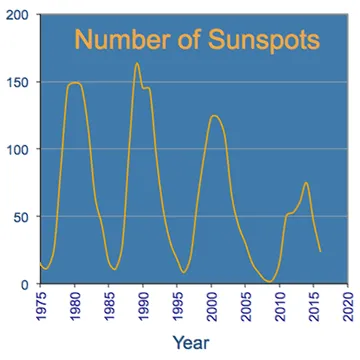Sunspots
Sunspots are dark, planet-sized regions that appear on the surface of the Sun. They are caused by twisting, chaotic magnetic fields from within the Sun’s convective zone. These powerful magnetic disturbances produce active regions on the Sun, which can often create solar flares and coronal mass ejections (CMEs). Because sunspots are associated with increased solar activity, space weather forecasters track these features to help predict solar storms that can impact Earth.

Sunspots on the Sun’s surface (left) and a close-up view of a sunspot group (right). The darker umbra region is in the center, surrounded by the lighter penumbra region.
NASA/Royal Swedish Academy of Sciences
Why Are Sunspots Dark?
Sunspots appear dark because they are cooler than their surroundings. Large sunspots are thousands of degrees cooler than the areas that surround them (about 4,200 °C for a sunspot compared to 6,000 °C for the photosphere surrounding it). Sunspots are only dark in contrast to the bright face of the Sun. If you could cut an average sunspot out of the Sun and place it elsewhere in the night sky, it would be about as bright as the full Moon. Sunspots have a lighter, outer section called the penumbra and a darker, central region named the umbra.
Sunspots and the Solar Cycle

The image with no spots (left) was taken near the solar minimum in December 2019, while the image with many sunspots (right) was taken near the solar maximum in April 2014.
NASA's Solar Dynamics Observatory/Joy Ng
Sunspots can last for weeks or even years before dissipating. The number of sunspots varies over a multi-year cycle. Historical records going back to the 1700s reveal that this sunspot cycle is roughly eleven years long — though sometimes it is longer or shorter.
The Sun is typically very active when sunspot counts are high. A peak in the sunspot count is referred to as a time of solar maximum, whereas a period when few or no sunspots appear is called a solar minimum.
The 11-year sunspot cycle is actually half of a longer, 22-year cycle of solar activity During this period, sunspot counts reach maximum and minimum twice.
How Do Sunspots Impact Earth?

This graph shows the number of sunspots counted each year for several decades. Notice how the sunspot count rises and falls in an 11-year cycle.
UCAR/NOAA's NGDC
Sunspots can cause geomagnetic storms in Earth’s magnetosphere. During a solar maximum, when sunspot numbers are at their peak, the Sun emits more radiation than usual. Plasma emitted from the Sun shoots millions of electrons and protons toward Earth. These charged solar particles can enter the atmosphere and create beautiful auroras, but they can also disrupt infrastructure, such as satellites, navigation, communications, and the electric power grid. The Space Weather Prediction Center monitors solar activity, such as sunspots and solar flares, so we can prepare for potential disruptions.